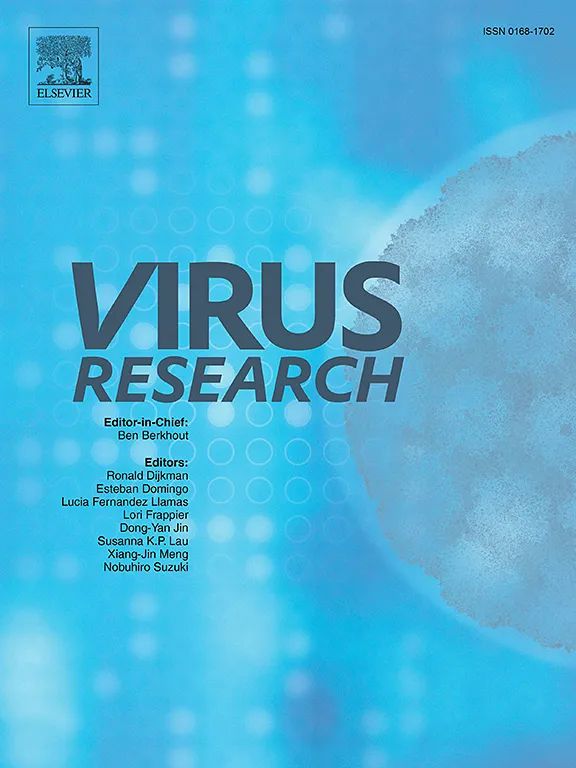参与鲣鱼干发酵的曲霉真菌中的霉菌病毒。
IF 2.5
4区 医学
Q3 VIROLOGY
引用次数: 0
摘要
真菌被用于奶酪、日本清酒和酱油等食品的发酵。然而,人们对参与食品发酵的真菌感染病毒的多样性了解甚少。发酵鲣鱼干("katsuobushi")是日本最重要的加工海产品之一。参与鲣鱼发酵的真菌被称为鲣鱼霉,据报道,曲霉属真菌在发酵过程中在鲣鱼表面占主导地位。由于在曲霉属成员中发现了各种霉菌病毒,我们推测葛粉霉菌也会感染霉菌病毒。在这里,我们描述了通过片段和引物连接双链 RNA 测序从分离的葛氏霉菌(Aspergillus chevalieri 和 A. sulphureus)中检测到的属于 6 个科(Chrysoviridae、Fusariviridae、Mitoviridae、Partitiviridae、Polymycoviridae 和 Pseudotiviridae)的 7 种新型霉菌病毒。车瓦利曲霉镰刀菌病毒 1 有一个独特的双片段基因组,而其他已知的镰刀菌病毒只有一个基因组片段。感染了切瓦里曲霉多粘病毒 1(AchPmV1)的切瓦里曲霉亲本菌株与不含 AchPmV1 的同源分离株之间的表型比较表明,AchPmV1 会抑制宿主的早期生长。这项研究揭示了感染葛缕子霉菌的霉菌病毒的多样性,并深入探讨了霉菌病毒对参与发酵的真菌的影响。本文章由计算机程序翻译,如有差异,请以英文原文为准。
Mycoviruses from Aspergillus fungi involved in fermentation of dried bonito
Fungi are exploited for fermentation of foods such as cheese, Japanese sake, and soy sauce. However, the diversity of viruses that infect fungi involved in food fermentation is poorly understood. Fermented dried bonito (“katsuobushi”) is one of the most important processed marine products in Japan. Fungi involved in katsuobushi fermentation are called katsuobushi molds, and Aspergillus spp. have been reported to be dominant on the surface of katsuobushi during fermentation. Because various mycoviruses have been found in members of the genus Aspergillus, we hypothesized that katsuobushi molds are also infected with mycoviruses. Here, we describe seven novel mycoviruses belonging to six families (Chrysoviridae, Fusariviridae, Mitoviridae, Partitiviridae, Polymycoviridae, and Pseudototiviridae) from isolated katsuobushi molds (Aspergillus chevalieri and A. sulphureus) detected by fragmented and primer-ligated double-stranded RNA sequencing. Aspergillus chevalieri fusarivirus 1 has a unique bi-segmented genome, whereas other known fusariviruses have a single genomic segment. Phenotypic comparison between the parental A. chevalieri strain infected with Aspergillus chevalieri polymycovirus 1 (AchPmV1) and isogenic AchPmV1-free isolates indicated that AchPmV1 inhibits the early growth of the host. This study reveals the diversity of mycoviruses that infect katsuobushi molds, and provides insight into the effect of mycoviruses on fungi involved in fermentation.
求助全文
通过发布文献求助,成功后即可免费获取论文全文。
去求助
来源期刊

Virus research
医学-病毒学
CiteScore
9.50
自引率
2.00%
发文量
239
审稿时长
43 days
期刊介绍:
Virus Research provides a means of fast publication for original papers on fundamental research in virology. Contributions on new developments concerning virus structure, replication, pathogenesis and evolution are encouraged. These include reports describing virus morphology, the function and antigenic analysis of virus structural components, virus genome structure and expression, analysis on virus replication processes, virus evolution in connection with antiviral interventions, effects of viruses on their host cells, particularly on the immune system, and the pathogenesis of virus infections, including oncogene activation and transduction.
 求助内容:
求助内容: 应助结果提醒方式:
应助结果提醒方式:


